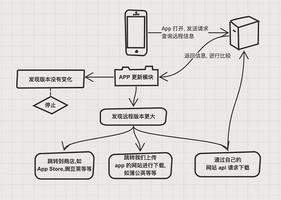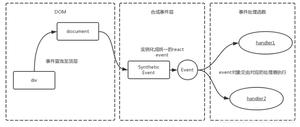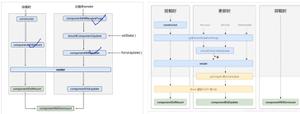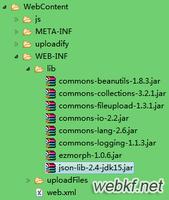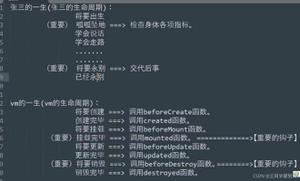react新旧版本生命周期函数讲解

react在引入 Fiber 之后,其生命周期也有所变化,新增了一些生命周期函数,同时也建议使用者废弃一些生命周期函数,下面博主对比一下react v16.3之前的生命周期与react v16.4及之后的生命周期函数。
一、生命周期图整体对比
1.1 react v16.3之前版本
挂载
当组件实例被创建并插入 DOM 中时,其生命周期调用顺序如下:
- constructor()
- componentWillMount()
(即将过时) - render()
- componentDidMount()
更新
当组件的 props 或 state 发生变化时会触发更新。组件更新的生命周期调用顺序如下:
- componentWillReceiveProps()
(即将过时) - shouldComponentUpdate()
- componentWillUpdate()
(即将过时) - render()
- componentDidUpdate()
- componentWillReceiveProps()
卸载
当组件从 DOM 中移除时会调用如下方法:
- componentWillUnmount()
1.2 react v16.4开始的版本,可查看 react生命周期图谱
挂载
当组件实例被创建并插入 DOM 中时,其生命周期调用顺序如下:
- constructor()
- static getDerivedStateFromProps()
(新增) - render()
- componentDidMount()
更新
当组件的 props 或 state 发生变化时会触发更新。组件更新的生命周期调用顺序如下:
- static getDerivedStateFromProps()
(新增) - shouldComponentUpdate()
- render()
- getSnapshotBeforeUpdate()
(新增) - componentDidUpdate()
- static getDerivedStateFromProps()
卸载
当组件从 DOM 中移除时会调用如下方法:
- componentWillUnmount()
错误处理
当渲染过程,生命周期,或子组件的构造函数中抛出错误时,会调用如下方法:
- static getDerivedStateFromError()
(新增) - componentDidCatch()
(新增)
- static getDerivedStateFromError()
新增其他 APIs
- forceUpdate()
二、生命周期函数变动点
通过上面的对比,我们可以知道,老板生命周期中有三个生命周期函数将会被废弃,分别是:
componentWillMount()componentWillReceiveProps()componentWillUpdate()
这三个生命周期函数都是在render之前调用的,官方也指出,这三个生命周期方法经常被误解和滥用,而且因为 fiber 的出现,它们潜在的误用问题可能更大。
新增的为:
getDerivedStateFromProps()getSnapshotBeforeUpdate()
对于废弃的生命周期函数,官方会采用逐步迁移的方式来实现版本的迁移:
- 16.3:为不安全的生命周期引入别名,UNSAFE_componentWillMount、UNSAFE_componentWillReceiveProps 和 UNSAFE_componentWillUpdate。(旧的生命周期名称和新的别名都可以在此版本中使用。)
- 未来 16.x 版本:为 componentWillMount、componentWillReceiveProps 和 componentWillUpdate 启用废弃告警。(旧的生命周期名称和新的别名都将在这个版本中工作,但是旧的名称在开发模式下会产生一个警告。)
- 17.0:删除 componentWillMount、componentWillReceiveProps 和 componentWillUpdate。(在此版本之后,只有新的 “UNSAFE_” 生命周期名称可以使用。)
下面将逐个对变化的生命周期函数进行解析:
2.1 componentWillMount()
与 componentWillMount() 相关的注意点主要集中在以下三点:
初始化state
对于这种场景,完全可以将初始化 state 的操作放到
constructor()中。获取异步数据
有一个常见的误解是,在
componentWillMount中获取数据可以避免第一次渲染为空的状态。所以有一些开发喜欢在componentWillMount做获取异步数据操作。实际上,这是不对的,因为 React 总是在
componentWillMount之后立即执行render,而获取数据一般都是异步操作。如果在componentWillMount触发时数据不可用,那么第一次render仍然会显示加载的状态,而不管你在哪里初始化获取数据。而且,在
componentWillMount做获取异步数据操作对于服务器渲染(不使用外部数据)和即将推出的异步渲染模式(可能多次启动请求)都存在问题。所以,获取异步数据这类场景建议统一放到componentDidMount中处理。添加事件监听器(或订阅)
如果我们在componentWillMount中增加,这可能导致服务器渲染(永远不会调用 componentWillUnmount)和异步渲染(在渲染完成之前可能被中断,导致不调用 componentWillUnmount)的内存泄漏。
人们通常认为 componentWillMount 和 componentWillUnmount 是成对出现的,但这并不能保证。只有调用了 componentDidMount 之后,React 才能保证稍后调用 componentWillUnmount 进行清理。所以这类场景也可在
componentDidMount中处理。
2.2 componentWillReceiveProps() 和 componentWillUpdate()
componentWillReceiveProps() 和 componentWillUpdate() 在 render()之前执行,而且可以获取的 当前和即将更新的 props 或 state,所以我们经常会在这两个生命周期中针对 props 或 state 变化时做一些逻辑处理。
基于 props 更新 state
componentWillReceiveProps(nextProps)函数中可以通过对比this.props和nextProps值的异同来做一些逻辑处理,例如基于 props 更新 state。从 16.3 版本开始,当 props 变化时,建议使用新的 static getDerivedStateFromProps 生命周期更新 state。创建组件以及每次组件由于 props 或 state 的改变而重新渲染时都会调用该生命周期。另外,componentWillReceiveProps可能在一次更新中被多次调用。因此,避免在此方法中产生副作用非常重要。而且官网中也推荐 派生 state 的简单替代方法 使组件可预测且可维护。注意点:在更新阶段,只要父组件会重新render,那么组件的componentWillReceiveProps()就会重新执行,而不是一定需要props的值有改动。调用外部回调
componentWillUpdate(nextProps, nextState)函数中可以通过对比this.props和nextProps,以及this.state和nextState来做一些逻辑处理。但是在异步模式下使用componentWillUpdate都是不安全的,因为外部回调可能会在一次更新中被多次调用。相反,应该使用componentDidUpdate生命周期,因为它保证每次更新只调用一次。这里需要注意一点就是两个生命周期函数执行时段不一样,componentDidUpdate(prevProps, prevState)是在render之后执行的,所以两者的入参有所区别。props 更新时获取外部数据
我们有时会在
componentWillReceiveProps(nextProps)和componentWillUpdate(nextProps, nextState)中对 props 的更新做判断,在 props 更新时获取外部数据.其实异步模式下使用componentWillReceiveProps(nextProps)和componentWillUpdate(nextProps, nextState)都是不安全的,都可能存在调用多次的情况。所以这次情况可以放在componentDidUpdate中处理,因为componentDidUpdate在一次更新中可以保证只被调用一次。更新前读取 DOM 属性
componentWillUpdate用于读取 DOM 属性。但是,对于异步渲染,“渲染”阶段的生命周期(如componentWillUpdate和render)和”提交”阶段的生命周期(如componentDidUpdate)之间可能存在延迟。如果这段时间内 DOM 属性发生了变化,那么从componentWillUpdate读取的 DOM 属性将过时。这个问题的解决方案是使用新的“提交”阶段生命周期
getSnapshotBeforeUpdate。这个方法在发生变化 前立即 被调用(例如在更新 DOM 之前)。它可以返回一个 React 的值(snapshot)作为参数传递给componentDidUpdate(prevProps, prevState, snapshot)方法,该方法在发生变化后立即被调用。
2.3 getDerivedStateFromProps(props, state)
新的 getDerivedStateFromProps() 生命周期方法是静态方法,所以在使用时,需要在前面加上 static 关键字,在组件实例化之后以及重新渲染之前调用。它可以返回一个对象来更新 state,或者返回 null 来表示新的 props 不需要任何 state 的更新。从方法的命名上也可以发现,该方法主要功能是实现上面的基于 props 更新 state。
2.4 getSnapshotBeforeUpdate(prevProps, prevState)
getSnapshotBeforeUpdate(prevProps, prevState) 生命周期方法在更新之前(如:更新 DOM 之前)被调用。此生命周期的返回值将作为第三个参数传递给 componentDidUpdate。(通常不需要,但在重新渲染过程中手动保留滚动位置等情况下非常有用。)主要针对上述的更新前读取 DOM 属性。
2.5 getDerivedStateFromError()
getDerivedStateFromError() 用于错误边界处理的生命周期函数,是静态方法, 与 getDerivedStateFromProps() 类似,使用时需要加上 static 关键字,并且返回一个对象来更新 state,只不过更新的 state 主要用于标识后代组件中出现了报错,但它本身的错误无法捕获。一般 我们用 static getDerivedStateFromError() 渲染备用 UI。
2.6 componentDidCatch()
我们一般使用 componentDidCatch(error, info) 来打印和收集错误信息。它接收两个参数:
- error —— 抛出的错误。
- info —— 带有 componentStack key 的对象,其中包含有关组件引发错误的栈信息。
关于更多的错误边界可参考官网描述:https://zh-hans.reactjs.org/docs/error-boundaries.html
2.7 forceUpdate()
调用 forceUpdate() 将致使组件调用 render() 方法,此操作会跳过该组件的 shouldComponentUpdate()。但其子组件会触发正常的生命周期方法,包括 shouldComponentUpdate() 方法。官方建议应该避免使用 forceUpdate(),尽量在 render() 中使用 this.props 和 this.state。
reference:
1、https://zh-hans.reactjs.org/blog/2018/03/27/update-on-async-rendering.html#updating-state-based-on-props
2、https://zh-hans.reactjs.org/docs/error-boundaries.html
以上是 react新旧版本生命周期函数讲解 的全部内容, 来源链接: utcz.com/z/383453.html

